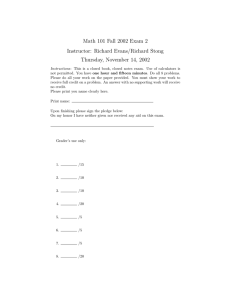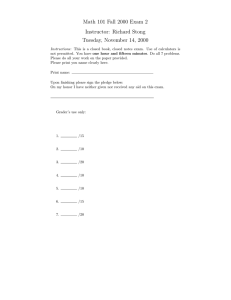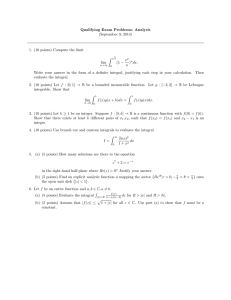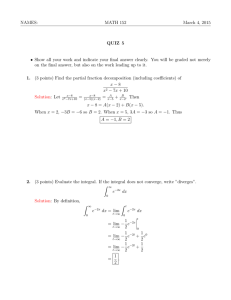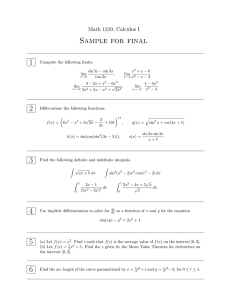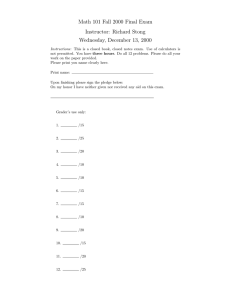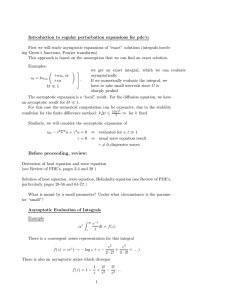Math 101 Fall 2001 Final Exam Instructor: Richard Stong
advertisement
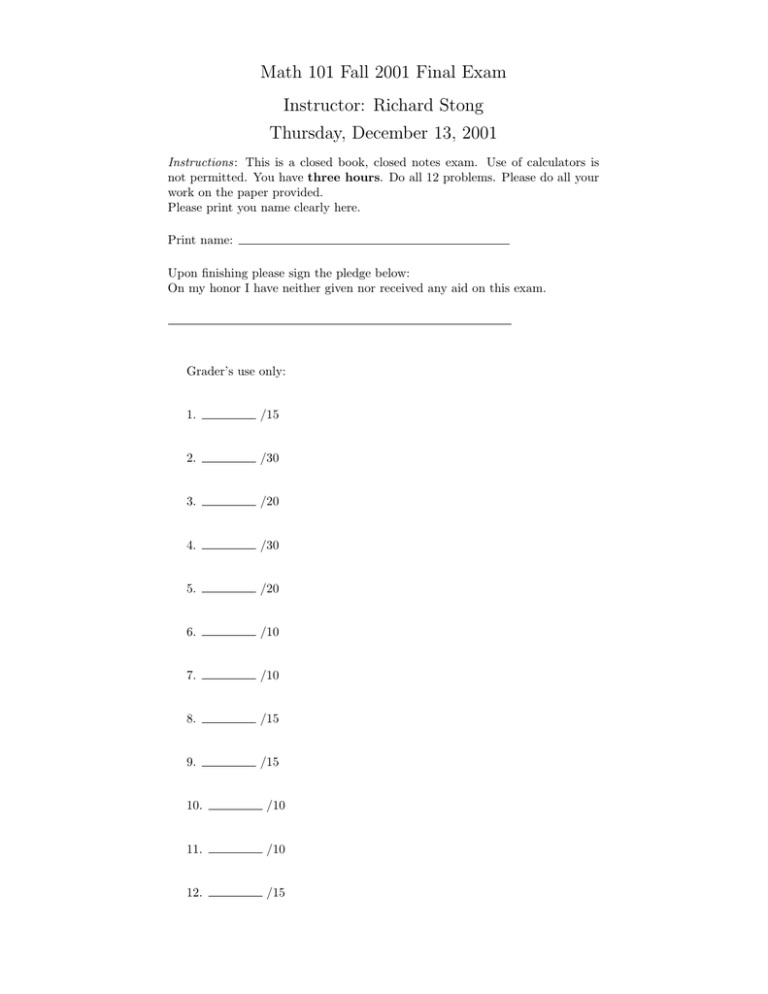
Math 101 Fall 2001 Final Exam Instructor: Richard Stong Thursday, December 13, 2001 Instructions: This is a closed book, closed notes exam. Use of calculators is not permitted. You have three hours. Do all 12 problems. Please do all your work on the paper provided. Please print you name clearly here. Print name: Upon finishing please sign the pledge below: On my honor I have neither given nor received any aid on this exam. Grader’s use only: 1. /15 2. /30 3. /20 4. /30 5. /20 6. /10 7. /10 8. /15 9. /15 10. /10 11. /10 12. /15 1. [15 points] Evaluate the following limits, if they exist. x2 −4x+3 2 x→3 x −x−6 (a) lim 2 ex −1 1−cos x x→0 (b) lim (c) lim x2/(x−1) x→1 2. [30 points] Compute the derivatives of the following functions. (a) f (x) = x3 ln(x + 3) (b) g(t) = sec(et ) (c) h(w) = arctan(3w2 ) (d) G(x) = R x2 1 sin t t dt (e) H(z) = (2 + (1 + 3 sin z)3 )1/2 3. [20 points] You want to build a rectangular box with no top, a square base and a volume of 500 cm3 . What dimensions will minimize the total surface area? Be sure to justify that your answer is really a global minimum. 4. [30 points] Let f (x) = x2 −3 x2 −1 . (a) Find all horizontal and vertical asymptotes of the graph y = f (x). At the vertical asymptotes compute both the left and right hand limits of f (x). (b) Find the intervals on which f (x) is increasing and those on which it is decreasing. (c) Find the critical points of f (x) and determine if they are local maxima or local minima. CONTINUED ON THE NEXT PAGE (d) Find the intervals on which f (x) is concave upward and those on which it is concave downward. (e) Sketch the graph of y = x2 −3 x2 −1 using your results in parts (a)-(d). 5. [20 points] Evaluate the following integrals. R (a) (x2 + 3)2 dx (b) R π/2 (c) R (d) R 0 cos x 2+sin x dx sec2 x etan x dx 3 √ x dx 1−4x8 6. [10 points] Evaluate R2 0 (1 + 3x2 )dx by computing lim n P n→∞ i=1 f (xi )∆x. No credit will be given for computing the integral in any other manner. 7. [10 points] Find the area of the region in the plane bounded by y = 4 − x2 and y = x2 − 2x − 8. 8. [15 points] Suppose a particle on a line has velocity function v(t) = t2 − 4t+3 for 1 ≤ t ≤ 4. Find the net distance travelled by the particle between t = 1 and t = 4 and the total distance travelled between t = 1 and t = 4. 9. [15 points] Let R be the region in the plane bounded by x = 4y − y 2 and the y-axis. Let S be the solid of revolution that results from revolving R about the y-axis. Express the volume of S as a definite integral in TWO ways, using the method of washers and the method of shells. Evaluate ONE of the two integrals (your choice). 10. [10 points] Find the length of the curve y = 2(x − 2)3/2 from x = 2 to x = 9. 11. [10 points] Express the area of the surface S obtained by revolving the curve y = x2 for 0 ≤ x ≤ 3 about the x-axis as a definite integral, but do not attempt to evaluate the integral. 12. [15 points] The population of Houston in 1960 was 1 million people and in 2000 it was 2 million people. Assuming exponential growth, find the population of Houston as a function of time. What will be the population of Houston in 2050? When will the population of Houston be 3 million?
